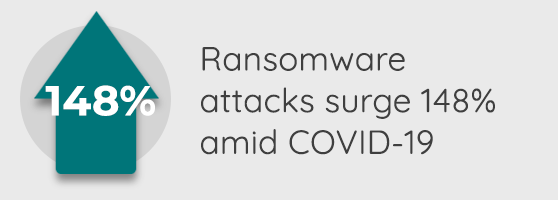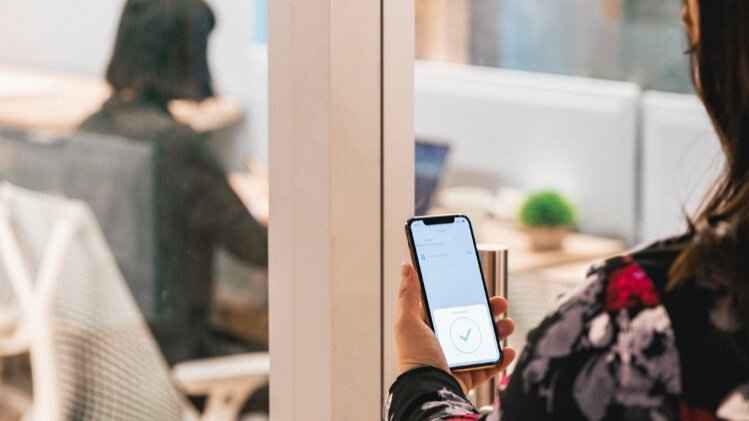The Most Common Coworking Space Security Issues - And How to Fix Them
Open-floor coworking spaces are the future of the modern workplace.
Coworking offices can be exciting places to work where technologies and ideas that change the future are born. The open-air desks and brightly lit spaces create an atmosphere of collaboration and innovation that makes it feel more like a community than an office.
Not only that, but they’re more cost-effective for startups and small businesses too. Coworking spaces often have different pricing tiers and payment plans that make them more accessible for ventures that are just getting their start. That, in turn, attracts working professionals from all walks of life, from entrepreneurs with the next world-changing idea, to freelancers working for themselves and living life on their own terms, to full-time employees whose companies have embraced the future of remote work.
However, with every new trend or technology comes challenges that can’t possibly be anticipated beforehand. Many of the same features that make coworking spaces fun and exciting also make them open to potential security threats. Open-air desks and common policies like Bring Your Own Device (BYOD) create a lot of potential security issues. If a coworking space is badly designed, planned, or managed anyone can just waltz in to steal items or hack into a coworking member’s computer.
A good coworking space needs to be physically secure, provide secure internet access, and have systems in place to monitor people coming and going from the space. Members need to feel like their belongings are safe, their data is secure, and that they are free to work in privacy and safety, all hours of the day and including weekends.
We'll lay out the most common security issues in coworking spaces in terms of physical security, internet security, and employee monitoring - and offer solutions to address them.
Why Care About Your Coworking Space Security?
Coworking spaces have a lot of advantages over a more traditional office building. You would be hard-pressed to find someone who would prefer sitting in a cold and sterile cubicle where they work by themselves day-in-day-out or a home-office where they’re surrounded by noisy pets and kids over a brightly lit and inviting coworking space where they can interact with like-minded peers.
With any new trend comes new challenges to overcome and risks to be addressed. The openness that coworking spaces provide comes with added vulnerability. That means more opportunities for thieves to steal people’s laptops, and hackers to steal people’s personal information, or even just visitors and passers-by that make distracting noises or make a coworking space feel crowded.
Apart from the obvious issue that an unsafe coworking space is bad for business, a lack of privacy and security also makes employees and members less productive.
2020 Clutch report
Employees don’t feel as secure with their belongings in a coworking space as they would in a private office. Almost a quarter of coworking employees say that their coworking space has security concerns and safety issues, according to a 2020 study.
It’s not just the physical security of a member having their laptop or phone stolen. Internet and data security is an issue in coworking spaces too.
Think of it this way: a traditional corporate office usually has all their employees use the same hardware, software, and tech stack. They all use the same laptops, the same operating system, the same office suite (Microsoft, Google, etc.), and the same email client.
It doesn’t work that way in a more modern coworking space. Most coworking spaces have a Bring Your Own Device (BYOD) policy where employees bring their own personal devices - laptops, smartphones, tablets - to the coworking space with them, and use the software they choose.
While in many ways choosing how you work fosters productivity, each of those personal devices poses a potential security threat.
A typical coworking space has about 90 members. Each member will bring at minimum a laptop and a cellphone with them, possibly a tablet or any number of smart devices into the coworking space every day. Each of those devices that are connected to the coworking space's wifi network. That makes for a total of 180 or more devices connected to your space's wifi that a hacker could breach.
Coworking Space Security Issues
A coworking space needs office security guidelines to feel safe, secure, and relatively private to enable coworking members to do their best work. The communal atmosphere of a coworking space where employees work side-by-side with each other creates security implications - both physical and virtual - that you need to address as an office manager.
Internet and Data Security
Coworking spaces draw all kinds of working professionals together under the same roof. Freelancers, tech startup founders, entrepreneurs, and remote employees all gather in coworking spaces to do their jobs, build their ventures or work on their projects. That's a lot of people with a lot of computers under one roof.
VMware Carbon Black Research
The mass shift to remote work that was spurred on by the COVID-19 pandemic also led to a rise in cybercrime. Ransomware attacks on businesses surged by 148% during the pandemic.
Physical Security
It’s not just hackers and terrorists you need to worry about. Burglars and corporate spies will also take advantage of your space’s weaknesses and vulnerability if you’re not careful. Physical and virtual security are both equally important.
This includes some common-sense, more traditional security procedures like having video surveillance cameras and an alarm system, but it can also involve installing mobile access control so that members can navigate around the space using their smartphones.
Physical security also pertains to visitor management and employee monitoring. Your coworking space needs processes in place to vet and screen the people who use it, as well as procedures for how visitors, day-pass members, and full-time office staff can navigate the space. If you always know who’s coming and going out of the coworking office then you’re better enabled to protect them.
It’s not just a security issue either - having sloppy visitor management procedures is bad business. When you don’t monitor coworking employees they can take calls and meetings in unused private office space for which they’re not paying for access, which can add up to a lot of potential lost revenue.
How to Make Your Coworking Space Secure
So much for all the things that can go wrong. Fortunately, each and every one of the potential security problems we mentioned has an appropriate solution that will make your coworking space secure. Here are some coworking office security best practices to follow, and how to implement them.
Internet and Data Security
Earlier we touched on how having multiple personal devices connected to the same wifi network makes coworking space cybersecurity attacks more likely. Here are some of the ways you can solve for that.
Switch to the Cloud
Having a centralized, cloud-based access control system helps ensure that your security software is updated against the latest security threats in real-time, and extends that security to every space and building in your network. It’s a much more cost-effective, efficient, and scalable solution compared to more traditional methods that are both expensive to install and hard to manage.
Not only that, but a cloud-based security software also gives you some neat analytics that gives you insight that helps you run your coworking space more like a business - like how often a meeting room or facility is used, and during what times of the day.
Install Mobile Access Control 2.0
Nexkey mobile access control system
Your employees already have everything they need to make your coworking space safe, secure, and convenient right in their front pocket. No more fiddling around with key cards or forgetting your key fobs in the car.
Smartphones are uniquely tied to someone’s identity. They have multiple security measures built-in, are easily trackable, and everyone who uses your coworking space already has one. That makes them perfect for tracking their entry and exit into your coworking space.
Mobile access control essentially turns your employees' smartphones into remote keys that let them come and go out of the coworking space in a way that doesn’t compromise its security.
Coworking space members are granted access to the space and unlock doors through an app on their phone, hands-free. Depending on their membership plans (day-pass, monthly, etc.) you can limit or deactivate their access after pre-determined periods of time.
Mobile access control also works on a cloud-based system that lets you control employee access from anywhere in the world.
Coworking Space Wifi
When it comes to cybersecurity, the best solutions are proactive rather than reactive. You would much rather have processes in place that prevent cybercriminals, hackers, and other bad actors from compromising the data of your members than have to put out the fires after the fact.
The first thing you should do is to have unique login credentials unique to each user. It’s also office security best practice to circulate SSID network names and passwords frequently. You could even go as far as having individualized private networks for each member.
Be sure to enable 2FA authentication as well. That extra step goes a long way towards covering up any potential gaps in your coworking spaces' security.
Moreover, be sure you outline your workplace security policy and procedures in your membership agreement and make sure that each member signs it before letting them in, just to make sure everyone is on board. You’ll be surprised how many people want to set up their own private networks - and that’s a no-go if you want a unified security system that keeps all your eggs in one basket.
Visitor Management and Employee Monitoring
Nexkey Space Usage and Occupancy Dashboard
It’s one thing to make sure that people can’t break into your coworking space by hacking your network or breaking-in during the dead of night, but what’s to stop someone from swiping a laptop off a desk when no one is looking or taking photos of a whiteboard just by walking through the front door and merging with the crowds of people who go about their business day after day?
Coworking spaces attract people from all kinds of professional backgrounds that use your space for all kinds of reasons. That’s not to mention visitors touring your space because they’re interested in a membership, office or facility staff, and so on.
That is a lot of people coming and going in and out of your coworking space, and a lot of opportunities for people to slip through the cracks and cause you a lot of headache.
Here are a few ways you can vet and screen the incoming members to your coworking space and make sure you know what they’re up to:
Visitors Log: Having one of these helps you keep track of members as well as non-members who come into your coworking space to attend meetings, make deliveries, and so on. A contactless check-in process done via tablet can help for analytics purposes and also reduce the risk of COVID transmission
Visitors' Badges: Badges are another staple of the modern coworking space. While a remote coworking access control system eliminates the need for members to have their own badges, it could still be useful to give these to temporary visitors to distinguish them from non-members. It can also be a good branding opportunity to show off your space’s benefits and sleek, modern design.
Government IDs: Requiring visitors to provide government-issued IDs is a good way to better understand just who exactly you’re allowing into your space and what they’re doing there. You can reserve the right to do background checks on anyone you give out a visitor’s badge to.
Wrapping Up
Coworking spaces can be fun and exciting places to work where potentially world-changing products and ideas are made. That said, they're still a relatively new trend. The conventional ways of thinking about office security don't apply to coworking spaces, and we need new ways to tackle the security issues involved.
Some of the coworking security tips and tricks to cover when it comes to your coworking space’s security include:
Physical security: Have well-lit entrances and exits, implement mobile access control, and switch to a cloud-based system so you can carefully monitor who's going about your coworking space and be able to make decisions quickly
Internet security: have unique login credentials for every member, rotate SSID network names and enable 2FA authentication
Visitor management: offer badges to temporary visitors, keep logs, and insist on government IDs on check-in
With Nexkey mobile access control and smart locks, you get a centralized system that lets you keep tabs on everyone on the floor, a cloud-based analytics dashboard that lets you remotely operate doors and monitor access both in and out, and smart locks that unlock with the simple touch of an authorized smartphone.





